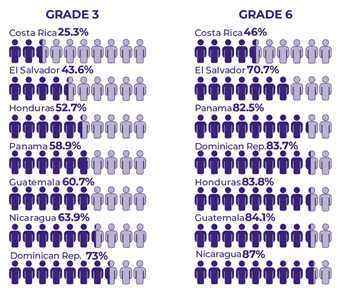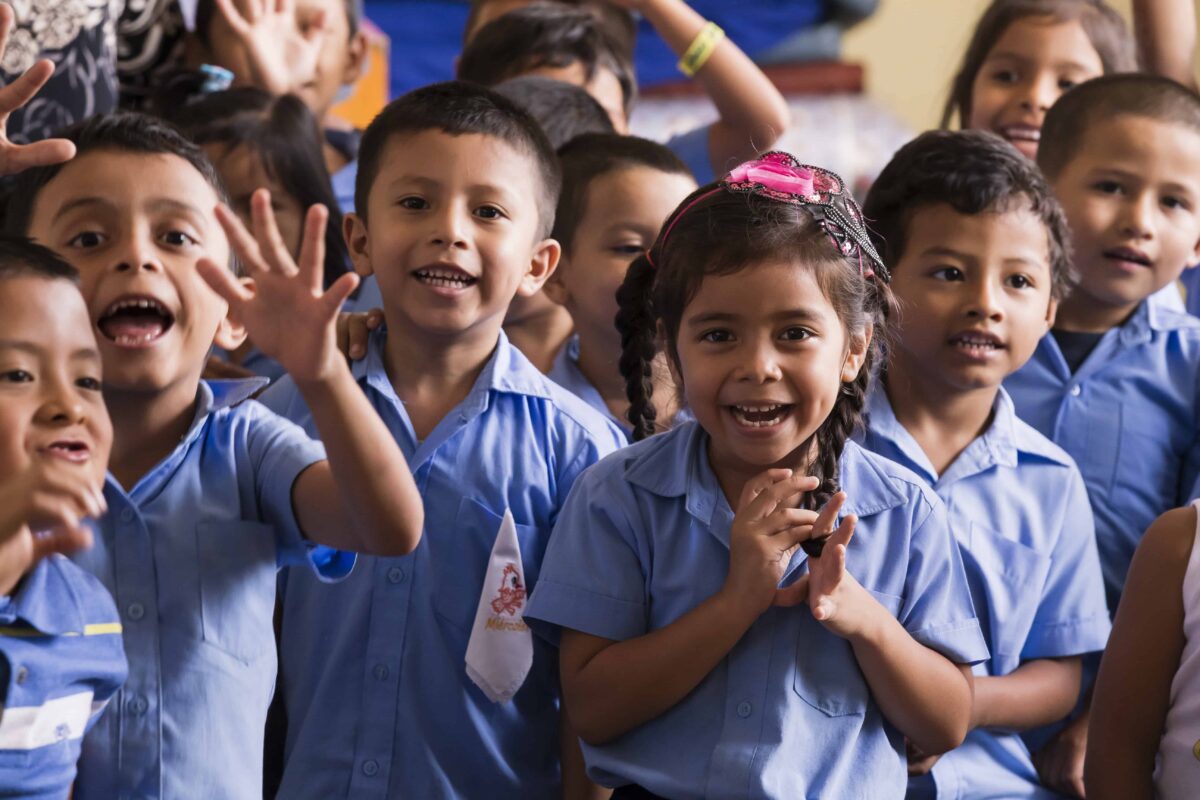América Latina y el Caribe (LACA) tiene un “problema de lectura” de larga data,” que se ha profundizado con el impacto de la pandemia en el sistema educativo de la región. Incluso después de importantes avances previos a la pandemia en la ampliación del acceso a la educación y cientos de millones de dólares en inversiones en programas de alfabetización, La región está muy por detrás en rendimiento de lectura en comparación con los estándares globales.. Al final, Más educación no se ha traducido en más educación de calidad ni en mejores resultados de aprendizaje para los niños de ALC.
Estudios recientes que comparan puntuaciones de lectura de 2013 y 2019 (ERCE, UNESCO) muestra eso para el grado 3 estudiantes, Las puntuaciones medias de lectura se mantuvieron estables o disminuyeron en la mayoría de los países participantes., con excepción de la República Dominicana, Paraguay, Perú y Brasil. Pero incluso en países que experimentan alguna mejora en los puntajes de lectura, la mayoría de los estudiantes todavía están por debajo de los estándares de nivel de grado en lectura.

El gráfico presenta los resultados ERCE de 2019 y muestra que en toda la región, el porcentaje de estudiantes que se desempeñan por debajo de las expectativas en lectura en ambos grados 3 y 6 osciló entre 25 por ciento y 87 por ciento,
Los puntajes más bajos provienen de América Central y el Caribe.. Guatemala, Nicaragua y la República Dominicana se encuentran consistentemente al final del grupo en ambos grados.
Entonces, lo que está sucediendo? ¿Por qué después de seis años y millones de dólares en programación educativa ha habido tan pocos avances en términos de la capacidad lectora de los niños en la región?? ¿Por qué no vemos mejoras?, cuando hemos aprendido tanto sobre el ciencia de la lectura en el ultimo 10 años, y la investigación nos ha señalado las habilidades básicas que los niños deben dominar para poder leer con fluidez y comprensión.?
Lo que hace que estos malos resultados de lectura sean aún más sorprendentes es el hecho de que el español es uno de los idiomas más fáciles de dominar debido a su alfabeto relativamente pequeño y su ortografía transparente., es decir cada una de las letras del alfabeto solo tiene un sonido. Compara esto con el idioma inglés., que tiene un alfabeto de tamaño similar pero donde cada una de nuestras letras puede emitir múltiples sonidos, creando muchas más combinaciones y reglas para que los niños aprendan. Por ejemplo, en Inglés, Las letras "ough" se pueden pronunciar de nueve maneras diferentes. (bruto, arado, a través de, aunque, pensamiento, exhaustivo, tos, hipo, lago) – uf! En español, Los lectores simplemente necesitan aprender el 27 letras del alfabeto y aproximadamente 30 fonemas correspondientes (o sonidos). Esto significa que es más fácil para un niño aprender las letras y sus sonidos y comenzar a combinarlos para formar palabras. (lo que llamamos decodificar).
Gough & La visión simple de la lectura de Tunmer (1986) identifica dos habilidades clave que se deben dominar para poder leer con comprensión y plantea una ecuación simple que ha sido probada en todos los idiomas y culturas.: “Decodificación x Comprensión del lenguaje = Comprensión de lectura”. En esta ecuación, Ambas habilidades son igualmente importantes y necesarias para que un niño pueda leer con comprensión.. Primero, deben poder decodificar texto. Esto significa que deben usar su conocimiento de las letras y los sonidos que hacen para pronunciar palabras y combinarlas en oraciones.. Este es el acto de decodificar., y debería ser un proceso relativamente rápido para que los niños aprendan a decodificar en español debido a la pequeña cantidad de letras y sonidos que se deben aprender.. Pero decodificar no es igual a comprender. Para que un niño realmente entienda lo que está leyendo, deben poder decodificar y comprender las palabras que están decodificando. Esto significa que el vocabulario debe enseñarse explícitamente., y los niños deben aprender vocabulario académico además del vocabulario que usarían fuera del entorno escolar.
Entonces, si sabemos cómo funciona la ciencia detrás de la creación de lectores fuertes, y que el español es un idioma relativamente sencillo de leer, ¿Por qué existe tal problema de lectura en ALC?? Hay muchas razones por las que no hemos logrado mover la aguja en las tasas de lectura en ALC en los últimos años., pero estos tres requieren atención especial y acción concertada:
- Apoyar la formación docente y crear conciencia para la adopción de prácticas docentes basadas en evidencia.: No hemos convencido a los ministerios de educación ni a las instituciones de formación docente para que adopten la ciencia de la lectura. Sin duda, Esto es algo que incluso aquí en Estados Unidos ha generado una gran controversia.. Simplemente busque en Google "Lucy Calkins y la alfabetización equilibrada".,”Y descubrirá varios artículos sobre cómo algunos de los planes de estudios más destacados se utilizan en los EE. UU.. no se alineaba con la ciencia de la lectura. Y este es el plan de estudios que se utilizó en el Teachers College de la Universidad de Columbia., que ha capacitado a cientos de miles de educadores en los EE. UU.. A los niños se les debe enseñar explícitamente cómo decodificar texto, y la fonética es la forma más efectiva de hacerlo, especialmente en un idioma como el español.
A 2020 Estudio regional que examina cómo las instituciones de formación docente en Centroamérica están formando docentes para enseñar lectura. (Andrade-Calderón, Piedra, & Vigilia) descubrió que muchas de las habilidades clave de lectura se están pasando por alto. Además, A los profesores no se les enseña CÓMO enseñar las habilidades clave de lectura.. La atención se centra mucho más en el contenido y la teoría, pero pasa por alto en gran medida cómo traducirlo en la práctica en un aula de escuela primaria.. Esto significa que cuando los profesores entran al aula, A menudo vuelven a hacer las mismas cosas que hicieron sus propios maestros porque eso es lo que han visto y experimentado.. Existe una necesidad real de actualizar los planes de estudio de formación docente inicial de la región para alinearlos con la evidencia sobre cómo los niños aprenden a leer y proporcionar modelos concretos y prácticas experienciales para los docentes antes de ingresar al aula..

- Alinear los planes de estudio de educación básica: Los planes de estudio de educación básica en ALC no suelen coincidir con la evidencia sobre qué habilidades necesitan los niños para aprender a leer.. Los planes de estudio no están estandarizados en toda la región e incluso dentro de cada país., A menudo hay una gran variación en los libros de texto que utilizan los profesores para enseñar a leer.. Muchos docentes de la región compran sus libros de texto en el mercado, y no hay suficiente capacitación o supervisión para garantizar algún tipo de uniformidad en todo el sistema. Además, Los planes de estudio que se utilizan en el aula a menudo no se alinean con los planes de estudio utilizados en las escuelas de formación docente, lo que genera una desconexión entre los docentes.. Los libros de texto y las guías docentes deberían basarse en la ciencia de la lectura y también deberían incluirse en las escuelas de formación docente., para que los maestros tengan la oportunidad de interactuar con el plan de estudios que se espera que enseñen antes de ingresar al aula.
- Apoyar la educación inclusiva que aborde las necesidades de los hispanohablantes no nativos.: La región no ha abordado seriamente el problema lingüístico que, según estimaciones de UNICEF, afecta a más de 40 millones de pueblos indígenas que hablan 420 diferentes idiomas en LAC. La evidencia es clara de que los niños aprenden mejor en un idioma que hablan y entienden.. Además, Proporcionar educación en el propio idioma del niño garantiza que la educación sea inclusiva., ya que los niños que no hablan el idioma nacional son a menudo los más marginados. La mayoría de los países de la región tienen una política de inmersión únicamente en español., lo que significa que los estudiantes se hunden o nadan. Para hablantes no nativos de español, como los hablantes de garífuna en Honduras o los hablantes de miskito en Nicaragua, Esto significa que los niños pequeños ingresan a la escuela para aprender matemáticas., lectura y otras materias en un idioma que no hablan. Esta es una gran desventaja para aquellos niños que deben aprender un idioma y aprender a leer en ese idioma al mismo tiempo., lo que hace que muchos de estos niños no aprendan a leer en absoluto o aprendan a leer mal, o simplemente abandonar la escuela por completo. Aún queda mucho por hacer para garantizar que los niños tengan el derecho humano básico de aprender en el idioma que hablan y entienden..
Desafortunadamente, El COVID-19 no ha hecho más que agravar la situación. Ahora nos enfrentamos a un período en el que los niños no han ido a la escuela o han experimentado una gran reducción del tiempo dedicado a sus tareas durante los últimos uno o dos años.. Esto es desastroso en una región donde los puntajes de lectura ya estaban disminuyendo.. Los niños de América Latina y el Caribe experimentaron algunos de los cierres de escuelas más prolongados del mundo debido a la COVID-19.
"De término medio, estudiantes de la región perdieron, total o parcialmente, dos tercios de todos los días escolares presenciales desde el inicio de la pandemia, con una pérdida estimada de 1.5 años de aprendizaje," de acuerdo a a un estudio del Banco Mundial. Este es un tema que debe abordarse, y hay que abordarlo ahora.
Mientras celebramos el Día Mundial de la Alfabetización, deberíamos reflexionar colectivamente sobre lo que implica ese esfuerzo. Las escuelas deben reabrirse por completo. Los docentes necesitan capacitación para evaluar el aprendizaje de los estudiantes y proporcionar medidas de recuperación para ayudarlos a ponerse al día.. Se necesitan campañas para alentar a los padres a enviar a sus hijos de regreso a la escuela y a reinscribirlos y continuar apoyando el aprendizaje dentro y fuera del aula.. Y, a más largo plazo, debemos garantizar que los planes de estudios de formación docente y los planes de estudios de educación básica estén alineados con la ciencia de la lectura., y que los niños tengan acceso a un idioma que hablen y comprendan. Este es un esfuerzo enorme, pero es absolutamente necesario para garantizar que las desigualdades de larga data en la región no se profundicen aún más..
Rebeca Piedra es el Director de la Unidad Técnica: Educación en Creative Associates International
Claudia Salazar Suarez es el Gerente Técnico Senior: Especialista LAC en Creative Associates International